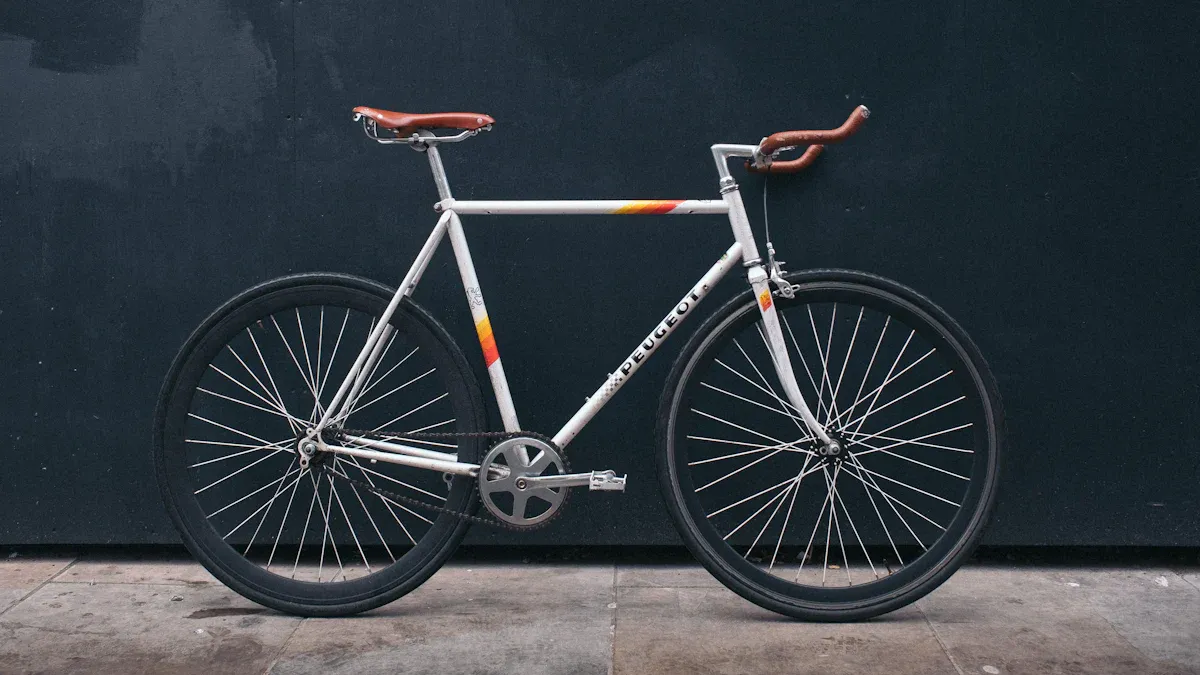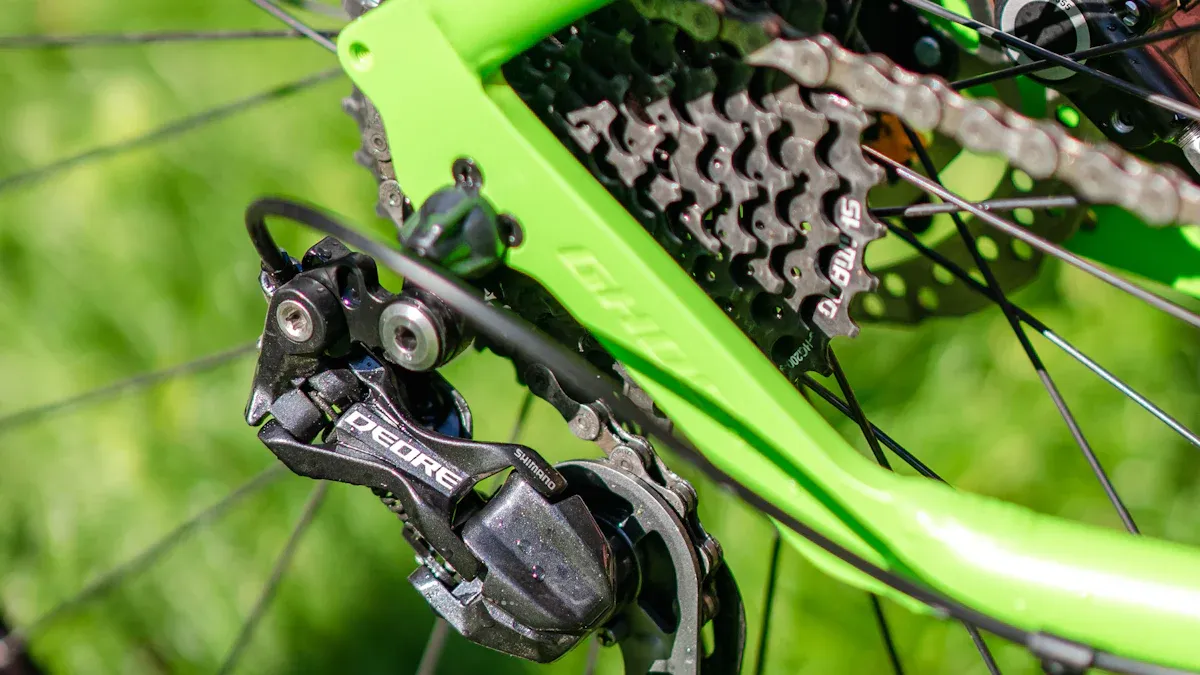
Choosing the right steel bike frame parts is very important. It affects your comfort and how well you ride. Good parts can make your ride better. They can also help your bike last longer. For example, steel frames can last 10 to 20 years. They are strong and give a smooth ride because they can bend a little.
When picking parts, think about your riding style. Also, consider your budget and what you like. Don’t make common mistakes. For example, don’t buy a whole bike without checking if the parts fit. Don’t forget the value of old steel bikes. Taking time to make smart choices will help you enjoy riding more.
Key Takeaways
Pick strong steel parts for lasting use and better performance. Hi-Ten is good for easy rides, while Cro-Mo is lighter for serious bikers.
Make sure bike frame parts fit well together. Check sizes and brands to avoid safety problems and ensure smooth riding.
Think about weight when choosing parts. A lighter bike helps you go faster and climb better, but balance strength and weight for the best ride.
Look at frame shape for comfort. The right size makes your ride better and helps prevent accidents.
Plan your budget carefully for steel bike parts. Spending on quality can save money on repairs and replacements later.
Material Quality

The quality of steel bike frame parts is very important. It affects how well your bike works and how long it lasts. You will usually find two main types of steel: Hi-Ten and Cro-Mo.
Types of Steel
Hi-Ten Steel: This type is popular for cheaper bikes. It is strong and can handle wear over time. Many riders like its flexibility, which makes for a comfy ride. For example, one rider has a 40-year-old Hi-Ten BMX bike. It has never cracked or bent, even after many years of tough use.
Cro-Mo Steel: This stands for chromium-molybdenum. Cro-Mo is lighter than Hi-Ten but may be less stiff. Some riders call Cro-Mo bikes “Wet Noodles” because they flex too much. This can make it hard to transfer power. If you want a bike that balances weight and performance, Cro-Mo could be a good choice, but it might not be best for casual riding.
Type of Steel | Properties |
|---|---|
Reynolds 953 | Stainless steel with strength over 2000 MPa, high impact strength, and fatigue resistance. |
Columbus Thron | High performance tubeset with great mechanical features and UTS of 800 MPa. |
Manganese-moly cold-worked steel, important in bike frame building. |
Butted Steel Tubing
Now, let’s discuss butted steel tubing. This method changes the wall thickness of the tube. By taking away extra material, butted steel tubing makes the frame stiffer while being lighter. This means you get a lighter bike that is still strong.
Benefits of Butted Steel:
Weight Reduction: You can save a pound or more compared to regular tubing. Higher grades of steel, like Reynolds 853, can be thinner but still strong.
Improved Ride Quality: The butting process moves stress points away from the welds. This leads to a smoother ride. Your bike can absorb road noise and bumps better, making your rides more fun.
Compatibility
When you pick steel bike frame parts, compatibility is very important. You need to make sure that every part fits well together. If the parts do not match, it can cause safety problems and make your bike work poorly. For example, if your frame cannot hold the weight of extra parts, it could lead to serious issues. Here are some key points to think about:
Frame and Component Fit:
The frame and seatpost must be the same size in diameter and length. Common sizes are 27.2mm, 30.9mm, and 31.6mm.
Riding a bike that does not fit right can be unsafe. A frame that is too big can make it hard to control. A frame that is too small can limit your movement. This raises the chance of accidents.
Getting the right size helps you ride better and transfer power well. You want your bike to feel like part of you, not a problem.
Tip: Always check if your frame works with the parts you want to use. This means making sure the bottom bracket, crankset, and wheel sizes are correct.
Brand Considerations:
Different brands have their own specifications. Some brands are known for being good and fitting well with steel frames. Here are a few popular ones:
Brand
Description
Shimano
A top maker known for smart and reliable products that fit many bike frames.
SRAM
An American leader in bike parts, famous for high-quality drivetrains and performance.
When you choose parts, think about how they work together. For example, if you pick a Shimano derailleur, make sure it works with your Shimano shifters. This helps with smooth gear changes and a better ride.
Note: Professional cyclists often focus on compatibility when building custom steel bikes. They check that the frame uses standard sizes for the bottom bracket, seat post, and rear spacing. This careful checking helps avoid problems later on.
Weight Considerations
Weight is very important for how your bike performs. A lighter bike helps you go faster and climb hills easier. Here are some things to think about:
Performance Impact
A lighter frame helps you speed up quickly.
Lighter frames make it easier to climb hills.
Heavier frames give stability and comfort on rough roads.
Steel bike frames usually weigh between 1200 to 2400 grams. In comparison, aluminum frames weigh about 1200 to 1600 grams, while carbon fiber frames are even lighter. Here’s a quick look at the weight differences:
Material | |
|---|---|
Steel | 1200 – 2400 |
Aluminum | ~1200 – ~1600 |
Carbon Fiber | Lighter than aluminum |
Strength vs. Weight
It’s important to find a good balance between strength and weight. High-strength steel often has a better strength-to-weight ratio than aluminum alloys. While aluminum can be stiffer, a strong steel frame can weigh about the same as an aluminum frame of equal strength. However, steel frames are usually stronger when hit and can carry heavier loads.
When you choose steel bike frame parts, think about how the way they are made affects both weight and durability. For example, butted steel tubing, especially triple butted types, can lower weight while keeping strength. This means you can have a better ride without losing performance.
Tip: Always choose quality when picking your steel bike frame parts. A well-made frame will improve your riding experience and help your bike last longer.
Frame Geometry

When you think about steel bike frame parts, geometry is very important. It affects how your bike feels and works. Knowing the sizes of the top tube and seat tube can help you find the right fit for your body.
Measurements
The top tube is the horizontal bar that connects the front and back of the frame. The seat tube goes up and down and holds the seat post. These sizes are key to making sure your bike fits you well. Here’s a quick reference table for standard sizes based on rider height:
Frame Size | Suggested Rider Height | Top-Tube Length, Horizontal | Seat-Tube Length |
|---|---|---|---|
XS | 4’10”-5’2″ | 512mm | 420mm |
S | 5’2″-5’6″ | 521mm | 480mm |
M | 5’6″-5’9″ | 537mm | 510mm |
L | 5’10”-6’2″ | 558mm | 540mm |
XL | 6’2″-6’4″ | 576mm | 570mm |
XXL | 6’4″+ | 600mm | 610mm |
Choosing the right frame size from these measurements can really improve your ride.
Fit and Comfort
The shape of your bike affects how comfy you feel while riding. A bike that fits well helps you keep a natural riding position. This is very important for long rides. Here are some key points to think about:
Proper fitting of the rider is key for comfort and efficiency.
Frame geometry affects handling, which can change how the bike feels on long rides.
For example, bikes made for endurance often have a more relaxed shape. This means they have a higher stack height and shorter reach. This makes it easier for you to stay comfy over long distances. Features like longer chainstays and a bigger wheelbase help with stability, which is important for comfort.
Tip: Always test ride a bike before you buy it. This way, you can feel how the geometry works for you. A bike that fits well will make your rides more fun and efficient.
By paying attention to frame geometry, you can choose steel bike frame parts that boost durability and performance. This careful choice helps you avoid confusion and ensures you get the best from your bike.
Budgeting for Parts
When you budget for steel bike frame parts, find a balance between cost and quality. Steel frames usually cost less than aluminum and carbon fiber. They are strong and comfortable, making them a smart choice for the long run. Here’s a quick look at the average price for good steel bike frame parts:
Item Description | Price Range |
|---|---|
Custom steel frame with fork | |
Steel bike frame components | $195.00 to $215.00 |
Cost vs. Quality
Buying better quality steel parts can save you money later. For example, chromoly frames are very strong. They can last for years of heavy use, which means fewer repairs and replacements. Here are some things that affect the price of steel bike frame parts:
Characteristics | Price Influence | |
|---|---|---|
High Tensile | Cheaper, weak strength-weight ratio | Lower prices because of cost-saving materials |
Chromoly | Stronger, lighter, can be butted | Higher prices due to better performance and strength |
Finding Value
To get the best value in steel bike frame parts, keep these tips in mind:
Check the welds and seams: Look for smoothness inside the tubes. This shows good craftsmanship.
Test ride different bikes: Feel the overall ride quality. This helps you see how different parts work.
Know frame geometry and material quality: Understanding these things will help you make better choices.
By focusing on these points, you can pick parts that fit your budget and improve your riding experience. Remember, a good steel frame can last for years, making it a smart investment for any cyclist.
Choosing the right steel bike frame parts can really change how you ride. Here are some important benefits to remember:
Durability: Steel frames last a long time, so they are a good choice.
Craftsmanship: Good steel frames show great skill in making them.
Comfort: Many riders say steel bikes feel ‘springy’ and ‘lively’.
Sustainability: Steel is often seen as better for the environment.
Emotional Connection: Riders often feel a strong bond with their steel bikes.
“When you take a steel bike out into the world… it’s a deliberate choice.”
Take your time when picking parts. Making smart choices can help you have a better and smoother ride. Remember, the right choices now can save you money on repairs later. For example, steel needs care every 3-5 years, while aluminum can last over ten years with little care.
Material | Maintenance Frequency | Common Issues | Additional Notes |
|---|---|---|---|
Steel | Every 3-5 years | Rust if not protected | Needs coatings to last longer. |
Aluminum | Minimal (every 10+ years) | Oxidation but easy to manage | Does not need paint; has a protective layer. |
So, take your time, do your homework, and enjoy the ride! 🚴♂️
FAQ
What type of steel is best for bike frames?
For bike frames, chromoly steel is often the best choice. It offers a great balance of strength and weight, making it durable yet lightweight. Hi-Ten steel is cheaper but less robust, suitable for casual riding.
How do I know if parts are compatible?
Check the specifications of your frame and components. Ensure sizes match, like the bottom bracket and seat post. Always verify that the brand and model of parts work together for smooth performance.
Can I customize my steel bike frame?
Absolutely! Steel frames are highly customizable. You can choose different components, colors, and geometries to fit your style and needs. This flexibility allows you to create a bike that feels just right for you.
How often should I maintain my steel bike?
You should maintain your steel bike every 3-5 years. Regular checks for rust and wear are essential. Keeping your bike clean and lubricated will extend its lifespan and ensure a smooth ride.
Are steel bike frames heavy?
Steel frames can be heavier than aluminum or carbon fiber, typically weighing between 1200 to 2400 grams. However, they offer excellent durability and comfort, making them a great choice for many riders.
See Also
Essential Advice for Selecting a Durable Cargo Bike Frame
Guidelines for Picking the Perfect Bike Frame for You
Evaluating Steel Mountain Bike Frames: Pros and Cons
